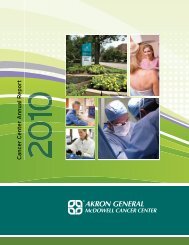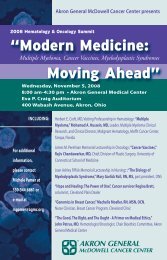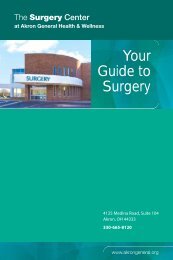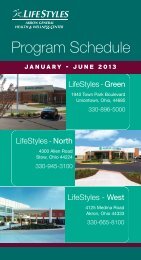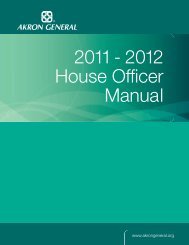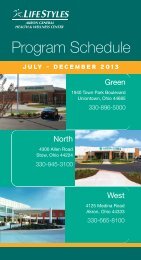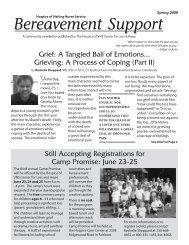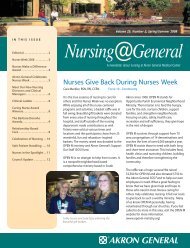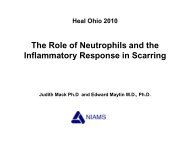Your Guide to Surgery - Akron General Medical Center
Your Guide to Surgery - Akron General Medical Center
Your Guide to Surgery - Akron General Medical Center
Create successful ePaper yourself
Turn your PDF publications into a flip-book with our unique Google optimized e-Paper software.
Additional instructions after your<br />
surgery and for home care<br />
Coughing & deep breathing<br />
Coughing and deep breathing will help prevent pneumonia, decrease pain,<br />
improve the oxygen in your blood and remove the anesthetic from your<br />
body. You will be asked <strong>to</strong> take three or four deep breaths followed by one<br />
deep cough, 10 times every hour. Deep breathing and coughing can be<br />
accomplished in a sitting or lying position.<br />
• Breathe out normally.<br />
• Clasp your hands over your abdomen.<br />
• Breathe in until you feel your abdomen push out.<br />
• Breathe out slowly.<br />
• Rest a few seconds.<br />
• Repeat three <strong>to</strong> four times then cough 1-2 times.<br />
• Relax and breathe normally.<br />
• Repeat technique 10 times every hour.<br />
Activity<br />
Movement and walking will decrease the chance of blood clots forming in<br />
your legs. You will be taught ankle pumps. When lying down, point your<br />
<strong>to</strong>es on both feet <strong>to</strong> your chin and stretch them out by pushing them away<br />
from your chin. Do this 10 times an hour. Flex your knees. Do not lie in one<br />
position. You may wake up with pumps on your feet or inflatable s<strong>to</strong>ckings<br />
on your legs. These help pump blood from your legs back <strong>to</strong> your heart.<br />
Pain control<br />
To help control your pain, your doc<strong>to</strong>r may order medication for you. After<br />
surgery, we may not be able <strong>to</strong> s<strong>to</strong>p all your pain, but we will help you <strong>to</strong><br />
be as comfortable as possible so you can rest and sleep. Pain medications<br />
will help you cough, take deep breaths, exercise your ankles, and recover<br />
more quickly.<br />
What method may be used <strong>to</strong> give you pain relief medicines?<br />
• Medicines given by mouth are either in tablet or liquid form. Most pain<br />
medicine is taken by mouth, however these medicines cannot be used<br />
if you can take nothing by mouth or if you are nauseated or vomiting.<br />
• Injections in<strong>to</strong> muscle or skin are medicines given by shots.<br />
• Injections given in<strong>to</strong> a vein are medicines given through a small tube<br />
called an intravenous (IV) catheter. The tip of the tube stays in the vein.<br />
A Patient Controlled Analgesia pump (PCA) may be used. You will be<br />
taught how and when <strong>to</strong> use the pump.<br />
• Injections given in<strong>to</strong> the spinal fluid or in<strong>to</strong> the epidural space through<br />
a catheter.<br />
7






